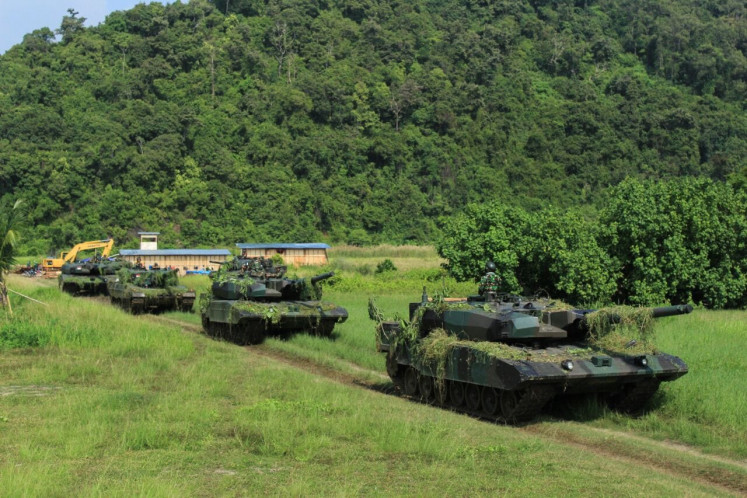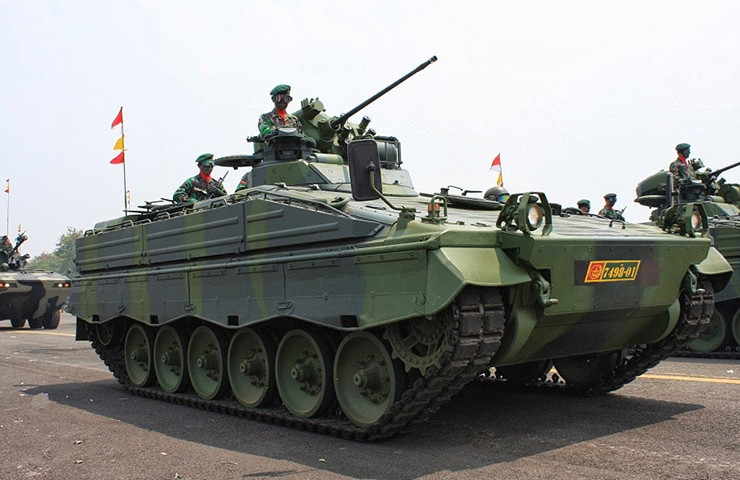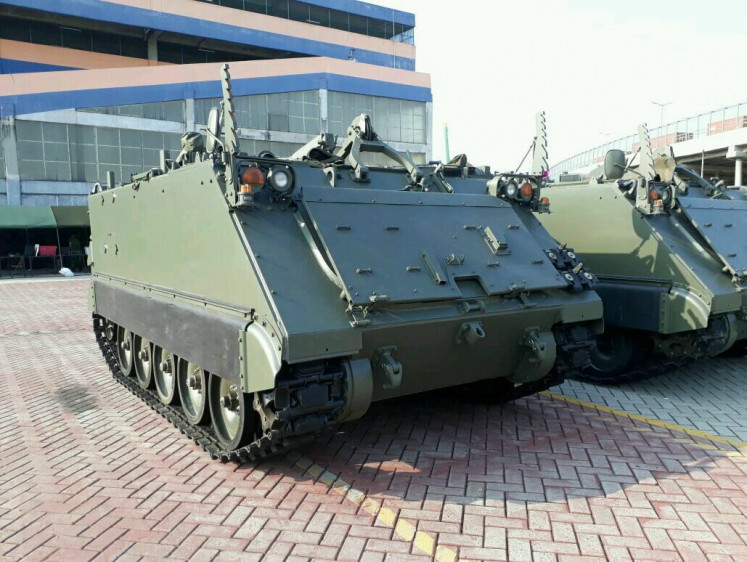Popular Reads
Top Results
Can't find what you're looking for?
View all search resultsPopular Reads
Top Results
Can't find what you're looking for?
View all search resultsUsed 'alutsista': Increasing the Indonesian Army's firepower
The Indonesian Army has procured several types of used tracked armored vehicles because state-owned land systems maker PT Pindad has yet to master the technology of manufacturing tracked armored vehicles.
Change text size
Gift Premium Articles
to Anyone
T
he Indonesian Military (TNI) is currently implementing the third strategic plan (Renstra) of the so-called Minimum Essential Force program to modernize its primary weapons systems (alutsista). By the end of the second Renstra in 2019, the Defense Ministry reported that the TNI had only modernized 63.19 percent of its alutsista compared to its goal of 75.54 percent, leaving 36.81 percent still to be modernized by 2024.
To fulfill the MEF target, one available option is to buy preowned alutsista from other countries. This approach, however, has sparked debate on whether Indonesia should buy all of its alutsista brand new to ensure higher quality or to purchase second-hand weapon systems to ensure quantity and faster deployment.
Indonesia has bought numerous second-hand alutsista for all three services of the TNI, and has received several grants of decommissioned weapon systems.
The Indonesian Army has procured several types of used tracked armored vehicles because state-owned land systems maker PT Pindad has yet to master the technology of manufacturing tracked armored vehicles.
Leopard 2A4 main battle tank
The most controversial acquisition was the 2013 purchase of Leopard 2A4 main battle tanks (MBTs), which had been decommissioned by the Bundeswehr (German military).
The Indonesian government paid US$280 million for 153 armored vehicles consisting of 41 Leopard 2A4 MBTs and 61 Leopard 2 RI MBTs as well as 50 Marder 1A3 infantry fighting vehicles (IFVs).
The Leopard 2A4 is equipped with a 120 mm smoothbore gun and two machine guns and has a weight of 52 tons. The weight was a point of contention among Leopard 2 detractors in Indonesia, who argued it was too heavy for Indonesian infrastructure.
The Leopard 2 RI is basically a 2A4 upgraded to be more versatile for urban combat and guerilla warfare. The upgrade package includes the installation of an advanced modular armor protection (AMAP) package that provides better protection against ambushes, improvised explosive devices (IED) and rocket-propelled grenades (RPG).
Indonesia also received 11 supporting armored vehicles, including a Bergepanzer 3Ri Buffel armored recovery vehicle, a Pionierpanzer 2Ri Dachs armored engineer vehicle and a BRLPZ-1 Brucklegenpanzer Biber armored vehicle-launched bridge.
Built between 1985 and 1992, the Bundeswehr’s decommissioned Leopard 2A4s were also bought by other countries, such as Singapore and Spain. Just like Indonesia, Singapore also conducted a modernization program for its Leopard 2s.
The Indonesian government reasoned that the MBTs were necessary to improve the capabilities of the Army’s Cavalry Corps, which only had light tanks at the time. Another reason was that neighboring countries already had MBTs, so the army needed to make a technological leap to close the gap.
Currently, the latest variant of the German MBT is the Leopard 2A6, which has better guns and protection.
Marder 1A3 infantry fighting vehicle
The Marder infantry fighting vehicle (IFV) was designed in the 1960s by German manufacturer Rheinmetall Landsysteme before production started in 1969 until 1975. With more than 2,000 units produced, the initial Marder 1A1 standard was upgraded to an 1A3 standard from 1988 to 1998 by adding additional armor and outside storage boxes.
The Marder’s main armament is a 20-millimeter autocannon, Milan antitank guided missile (ATGM) and 12.7-mm machine gun. With a crew of three, a Marder can carry six soldiers.
The TNI first deployed Marder into cavalry battalions before transferring them to infantry battalions, transforming them into mechanized infantry battalions.
Despite its relatively old age, the Marder has strengthened the Army’s mechanized infantry warfare capabilities by providing heavier firepower. Previously, the Army’s mechanized infantry used Pindad’s wheeled Anoa armored personnel carrier (APC), which only has machine guns.
Currently, the latest variant is the Marder 1A5, which comes with improved armor and protection.
Rheinmetall also offers an APC version of the Marder that can carry three crew and 12 infantrymen.
M109 A4 self-propelled gun
M109 self-propelled howitzer (tniad.mil.id/-)In 2017, Indonesia bought 36 M109A4-BE self-propelled howitzers (SPHs), which had been modernized before being decommissioned by Belgium. The purchase increased the fire power of the Indonesian Army’s Field Artillery Corps (Armed). The 155 mm howitzers are placed on a tracked platform. While purists would frown upon it, you can say that the M109 is a tank with an oversized gun.
Belgium bought the M109A4-BEs from 1984 to 1985 and modernized them from 2007 to 2008. The upgrade increased the SPH’s firepower and mobility. The SPH has an effective firing range of 21 kilometers, which can be increased to 30 km when using rocket assisted projectiles (RAP).
Indonesia received the SPH in two delivery batches of 18 units each in July 2017 and July 2018.
First entering service in the United States in 1963, the SPH’s latest iteration is the M109A7, which has a firing range of 45 km using the latest RAP type, the XM11113.
M113A1 armored personnel carrier
M113A1 armored personnel carrier (tniad.mil.id/-)It appears the Army has a special penchant for, or connection with, the Belgians. This was demonstrated by the arrival in 2014 to 2017 of 150 M113A1 armored personnel carriers (APCs) that had been decommission by the Belgian army.
With armor made of aluminum, the M113 is an iconic battle vehicle that started service in 1960 and was a ubiquitous actor in the Vietnam War when it was used as a battle taxi.
Belgium produced its M113A1s at home under with a license from the original US maker Food Machinery Company (FMC). With a crew of two, a M113 can carry up to 11 soldiers.
Indonesia began using M113s much later than its neighbors the Philippines, Singapore, Thailand, and former South Vietnam, which began using them in the 1960s and early 1970s.
With a capacity of two crew and 11 troops, the army has deployed M113s to several mechanized infantry battalions in addition to Pindad’s Anoa APCs. The main armament is a 12.7-mm machine gun.
While the M113 has moderate amphibious capabilities, the Army also bought five fully amphibious M113 Arisgators from Italian company Applicazioni Rielaborazioni Impianti Speciali (Aris) Spa. Aris offers a modification package to make the M113 fully amphibious.
The M113 is a versatile platform that has been developed for several derivative functions, such as antiaircraft, antitank, command and reconnaissance, mortar carrier and recovery.














